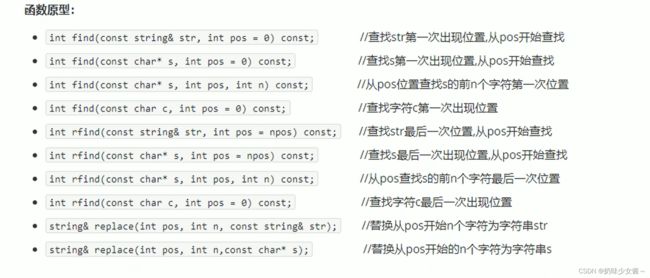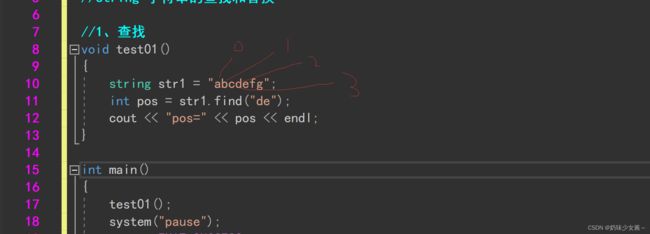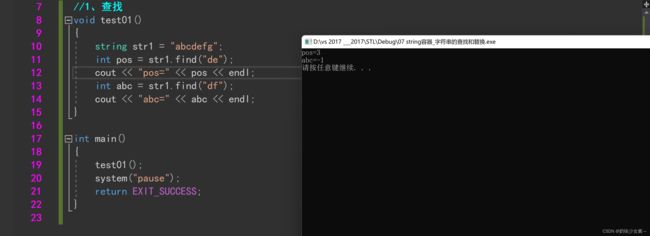STL——string、vector、deque容器
初识STL
- **STL的基本概念以及vector简单用法**
-
- **vector容器存放内置数据类型**
- **vector容器中存放自定义数据类型**
- **vector容器嵌套vector容器**
- **string容器**
-
- **string容器——构造函数**
- **string容器——赋值操作**
- **string容器——字符串拼接**
- **string容器——字符串的查找和替换**
- **string容器——字符串比较**
- **string容器——字符存取**
- **string容器——字符串的插入和删除**
- **string容器——字串获取**
- **vector容器**
-
- **vector容器——构造函数**
- **vector容器——赋值操作**
- **vector容器——容量和大小**
- **vector容器——插入和删除**
- **vector容器——数据存取**
- **vector容器——互换容器**
- **vector容器——预留空间**
- **deque容器**
-
- **deque容器——构造函数**
- **deque容器——赋值操作**
- **deque容器——大小操作**
- **deque容器——插入和删除**
- **deque容器——数据存储**
- **deque容器——排序操作**
- **STL案例**
-
- **评委打分**
STL的基本概念以及vector简单用法
STL大体分为六大组件,分别是:容器、算法、迭代器、仿函数、适配器(配接器)、空间配置器
1.容器:各种数据结构,如vector、list、deque、set、map等,用来存放数据。
2.算法:各种常用的算法,如sort、find、copy、for_each等
3.迭代器:扮演了容器与算法之间的胶合剂。
4.仿函数:行为类似函数,可作为算法的某种策略。
5.适配器:一种用来修饰容器或者仿函数或迭代器接口的东西。
6.空间配置器:负责空间的配置与管理。
容器:置物之所也
STL容器就是将运用最广泛的一些数据结构实现出来常用的数据结构:数组,链表,树,栈,队列,集合,映射表等
这些容器分为序列式容器和关联式溶容器两种:
序列式容器:强调值的排序,序列式容器中的每个元素均有固定的位置。
关联式容器:二叉树结构,各元素之间没有严格的物理上的顺序关系
算法:问题之解法也
有限的步骤,解决逻辑或数学上的问题,这一门学科我们叫做算法(Algorithms)算法分为:
质变算法和非质变算法。
质变算法:是指运算过程中会更改区间内的元素的内容。例如拷贝,替换,删除等等
非质变算法∶是指运算过程中不会更改区间内的元素内容,例如查找、计数、遍历、寻找极值等等
迭代器:容器和算法之间粘合剂
提供一种方法,使之能够依序寻访某个容器所含的各个元素,而又无需暴露该容器的内部表示方式。
每个容器都有自己专属的迭代器,迭代器使用非常类似于指针,初学阶段我们可以先理解迭代器为指针
算法必须要通过迭代器来访问容器中的元素
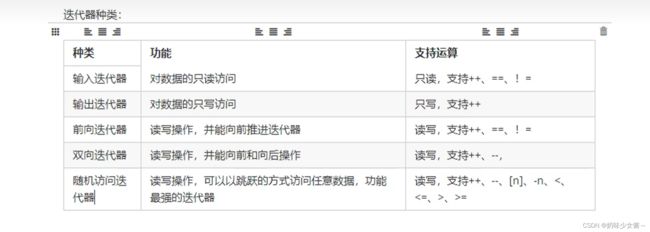
常用的容器中迭代器种类为双向迭代器和随机访问迭代器
vector容器存放内置数据类型
STL中最常用的容器为Vector,可以理解为数组,利用这个容器中可以实现插入数据、并遍历这个容器

iterator是迭代器的名称,是在vector类型下的

//#define _CRT_SECURE_NO_WARNINGS
//#include ::iterator itBegin = v.begin();//起始迭代器 指向容器中第一个元素
//vector::iterator itEnd = v.end();//结束迭代器 指向的是最后一个元素的下一个位置
//
第一种遍历方式
//while (itBegin != itEnd)
//{
// cout << *itBegin << endl;
// itBegin++;
//}
第二种遍历方式
//for (vector::iterator it = v.begin(); it != v.end(); it++)
//{
// cout << *it << endl;
//}
//第三种遍历方式 利用STL提供的遍历算法
for_each(v.begin(), v.end(), myPrint);//这里写一个函数名 利用了回调的技术
//在遍历的期间 调用了函数
}
int main()
{
test01();
system("pause");
return EXIT_SUCCESS;
}

第三种函数的源码:
这里是用了回调函数还有一个for循环来实现的
这里的迭代器可以看成指针,而解引用就是解这个指针,然后把解引用的元素放入到回调函数进行调用
解引用是解这个迭代器,也就是传入数组中的数

vector容器中存放自定义数据类型
#define _CRT_SECURE_NO_WARNINGS
#include vector容器嵌套vector容器
#define _CRT_SECURE_NO_WARNINGS
#include string容器
string容器——构造函数
string本质:
string是C++风格的字符串,而string本质上是一个类string和char区别:
char是一个指针
string是一个类,类内部封装了char,管理这个字符串,是一个char型的容器。
特点:
string类内部封装了很多成员方法
例如︰查找find,拷贝copy,删除delete替换replace,插入insertstring管理char所分配的内存,不用担心复制越界和取值越界等由类内部进行负责*

#define _CRT_SECURE_NO_WARNINGS
#include string容器——赋值操作
#define _CRT_SECURE_NO_WARNINGS
#include string容器——字符串拼接
#define _CRT_SECURE_NO_WARNINGS
#include string容器——字符串的查找和替换
#define _CRT_SECURE_NO_WARNINGS
#include string容器——字符串比较
#define _CRT_SECURE_NO_WARNINGS
#include 
总结:字符串对比主要是用于比较两个字符串是否相等,判断谁大谁小的意义并不是很大
string容器——字符存取
#define _CRT_SECURE_NO_WARNINGS
#include string容器——字符串的插入和删除
#define _CRT_SECURE_NO_WARNINGS
#include string容器——字串获取
#define _CRT_SECURE_NO_WARNINGS
#include 这里find找到@的位置为8是数组下标,我们要截取的zhangsan这个字符串长度也是8,直接把pos传进去就行了

总结:灵活的运用求子串功能,可以在实际开发中获取有效的信息
vector容器
vector容器——构造函数
功能:
vector数据结构和数组非常相似,也称为单端数组
vector与普通数组区别:
不同之处在于数组是静态空间,而vector可以动态扩展
动态拓展:
并不是在原空间之后续接新空间,而是找更大的内存空间,然后将原数据拷贝新空间,释放原空间

vector的迭代器是支持随机访问的迭代器
这里的begin()是闭区间,end()是开区间

#define _CRT_SECURE_NO_WARNINGS
#include 这里打印函数为什么要加入引用的原因是:
不加引用程序就需要重新构建一个vector,这会浪费很多的计算机资源,加引用就是为了避免这个的
vector容器——赋值操作
#define _CRT_SECURE_NO_WARNINGS
#include vector容器——容量和大小
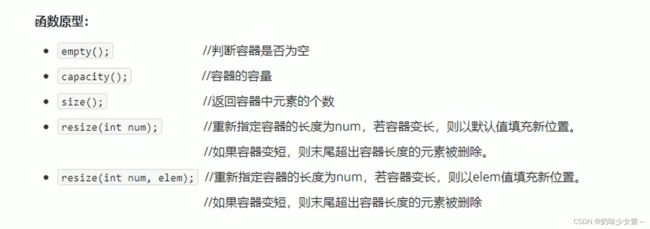
判断是否为空— empty
返回元素个数— size
返回容器容量— capacity
重新指定大小 — resize
#define _CRT_SECURE_NO_WARNINGS
#include vector容器——插入和删除
#define _CRT_SECURE_NO_WARNINGS
#include vector容器——数据存取
#define _CRT_SECURE_NO_WARNINGS
#include 
总结:
除了用迭代器获取vector容器中元素,[]和l也可以
front返回容器第一个元素
back返回容器最后一个元素
vector容器——互换容器
#define _CRT_SECURE_NO_WARNINGS
#include (v)//匿名对象 调用了一次拷贝构造函数
//用v所用的内存空间来初始化x的内存空间
//.swap(v)相当于容器之间的交换
//匿名对象的特点 执行完就会回收空间
vector<int>(v).swap(v);
cout << "v的容量: " << v.capacity() << endl;
cout << "v的大小: " << v.size() << endl;
}
int main()
{
//test01();
test02();
system("pause");
return EXIT_SUCCESS;
}
vector容器——预留空间
功能:
减少vector在动态扩展容量时的扩展次数

没有设置预留空间:
#define _CRT_SECURE_NO_WARNINGS
#include #define _CRT_SECURE_NO_WARNINGS
#include deque容器
deque容器——构造函数
功能:双端数组,可以对头端进行插入删除操作
理解为双端队列
deque与vector区别:
vector对于头部的插入删除效率低,数据量越大,效率越低.
deque相对而言,对头部的插入删除速度回比vector快
vector访问元素时的速度会比deque快,这和两者内部实现有关
1. 内部实现方式不同:vector是使用连续的内存空间存储数据,而deque则是使用一段连续的内存空间存储指向另一段内存空间的指针,这样就可以实现在两端高效地插入和删除元素。
2. 访问元素的方式不同:vector可以使用下标访问元素,而deque则需要使用迭代器访问元素。
3. 内存分配方式不同:vector在内存不足时会重新分配一块更大的内存空间,并将原有数据复制到新的内存空间中,这样会导致内存的浪费;而deque则会在需要时分配新的内存空间,不会浪费内存。
4. 其实,deque可以使用数组下标来访问元素。但是需要注意的是,deque是一个双端队列,支持在队列的两端进行插入和删除操作,因此使用数组下标访问元素时需要考虑队列的头尾位置,以及队列是否为空的情况。另外,使用数组下标访问元素时,需要保证下标的合法性,否则可能会导致访问越界的错误。因此,建议在使用deque时,优先使用其提供的成员函数来进行元素的访问和操作。
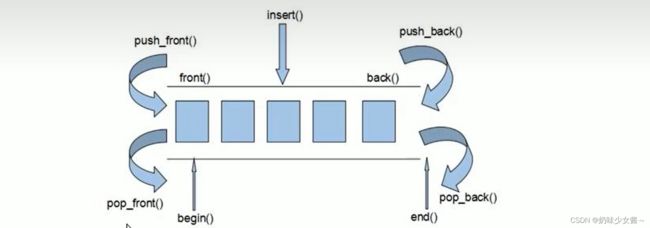

deque内部工作原理:
deque内部有个中控器,维护每段缓冲区中的内容,缓冲区中存放真实数据
中控器维护的是每个缓冲区的地址,使得使用deque时象一片连续的内存空间
deque容器的迭代器也是支持随机访问的

#define _CRT_SECURE_NO_WARNINGS
#include deque容器——赋值操作
#define _CRT_SECURE_NO_WARNINGS
#include deque容器——大小操作
deque相较于vector少了容量操作,也就是说容量没有限制
#define _CRT_SECURE_NO_WARNINGS
#include deque容器——插入和删除
#define _CRT_SECURE_NO_WARNINGS
#include deque容器——数据存储
#define _CRT_SECURE_NO_WARNINGS
#include deque容器——排序操作
#define _CRT_SECURE_NO_WARNINGS
#include STL案例
评委打分
有5名选手:选手ABCDE,10个评委分别对每1名选手打分,去除最高分,去除评委中最低分,取平均分。
1.创建五名选手,放到vector中
2.遍历vector容器,取出来每一个选手,执行for循环,可以把10个评委打分存到deque容器中
3.sort算法对deque容器中分数排序,去除最高和最低分
4.deque容器遍历一遍,累加总分
5.获取平均分
#define _CRT_SECURE_NO_WARNINGS
#include ::iterator dit1 = d.begin(); dit1 != d.end(); dit1++)
//{
// cout << *dit1 << " ";
//}
//cout << endl;
//排序
sort(d.begin(), d.end());
//去除最高分和最低分
d.pop_back();
d.pop_front();
//去平均分
int sum = 0;
for (deque<int>::iterator dit = d.begin(); dit != d.end(); dit++)
{
sum += *dit;//累加每个评委的分数
}
int avg = sum / d.size();
//将平均分 赋值给选手身上
it->m_Score = avg;
}
}
void showScore(vector<Person>&v)
{
for (vector<Person>::iterator it = v.begin(); it != v.end(); it++)
{
cout << "选手姓名: " << it->m_Name << " 平均分: " << it->m_Score << endl;
}
}
int main()
{
//随机数种子
srand((unsigned int)time(NULL));
//1、创建5名选手
vector<Person>v;//存放选手容器
createPerson(v);
//测试
//for (vector::iterator it = v.begin(); it != v.end(); it++)
//{
// cout << "姓名: " << (*it).m_Name << " 分数: " << (*it).m_Score << endl;
//}
//2、给5名选手打分
setScore(v);
//3、显示最后得分
showScore(v);
system("pause");
return EXIT_SUCCESS;
}







